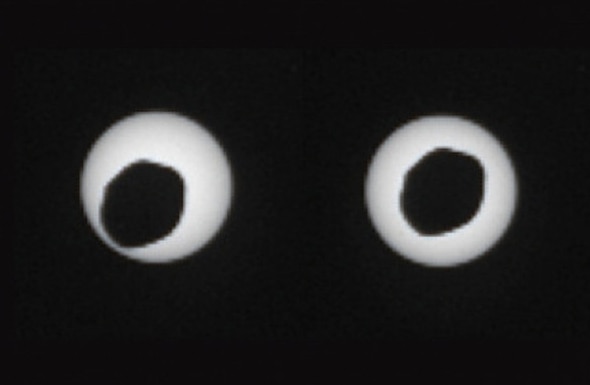Create a free profile to get unlimited access to exclusive videos, sweepstakes, and more!
Phobos’ Googly-Eyed Transit

Mars has two moons: Phobos and Deimos. Both are lumpy, rather irregular potatoes, and quite small. Deimos is only 15 kilometers along its long axis, and Phobos is about 27.
Phobos is weird for more reasons, too. It orbits the planet very low, only 6,000 km or so above the surface of Mars. It moves so quickly around the planet that it actually goes around faster than Mars rotates, so it rises in the west and sets in the east—twice each Martian day.
It just so happens that the rover Curiosity is in a location on Mars where things line up just right such that every so often Phobos passes directly in front of the Sun. I’ve written about these transits before, but I somehow missed this one from Aug. 20, 2013. Happily, Robert Krulwich on his NPR blog wrote about it, to my delight.*
The photo above shows two images of the transit, which I couldn’t resist because it looks a bit googly-eyed. Someone tell Anne Wheaton and Bonnie Burton!
But those are just two images; Curiosity took quite a few … and the folks at NASA’s JPL put them together into this amazing video showing the moon moving right across the face of the Sun:
I love this video because it shows the whole transit, because the transit isn’t partial (with the moon cutting a shallow chord across the Sun, say), and because it’s in real time! The frame rate was set so that what you see here is pretty much what Curiosity saw: a 37-second long event.
On Earth, the Moon and Sun are about the same apparent size in the sky, because in a cosmic coincidence the Sun is 400 times bigger than the Moon but also 400 times farther away. Phobos is smaller than the Moon, but much closer to Mars, so it appears about half the size of our Moon. But Mars is also farther from the Sun, so the Sun looks smaller there too, and Phobos does a decent job covering it up.
It’s really odd to see something like this, knowing that what you’re seeing isn’t an airplane or a cloud, but an actual rocky moon orbiting far overhead.
… and of course, that’s nothing compared with knowing that this sequence was taken by a machine sitting on the surface of another world.
*Correction, July 28, 2014: This post originally misspelled the name of NPR.


























